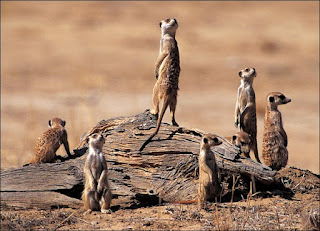The meerkat, or the Suricata suricatta, is a member of the mongoose family. The name meerkat is borrowed from Afrikaans, and it is the result of misidentification. Meerkat literally means "lake cat" and refers to the guenon (a type of monkey), neither of which aptly describes this little critter. They live in all parts of the Kalahari Desert, which includes parts of Botswana, Namibia, Angola, and South Africa. Zambian and Zimbabwean popular belief hold the meerkat to be a sung angel that protects villages from the moon devil and even from werewolves. It's too bad that Stephanie Meyer didn't know about meerkats and their reputation as Sun Angels, or else they may have featured in a new Twilight novel where vampires and meerkats join forces against those pesky werewolves. But I digress - Twilight rants are dangerous and time consuming, so I must stop myself before this gets out of hand.
The meerkat is a small critter, weighing in at only about 1.6 pounds. It has a long slender body that is between 10 and 14 inches in length with an additional tail length of 7-10 inches. Unlike other mongoose species, it does not have a bushy tail. The meerkat uses this long, thin tail to balance when standing up and for signaling. The eyes always have black patches around them and act as natural sunglasses. Their small ear can be closed to make sure dirt stays out when they are digging. They have binocular vision with a large peripheral range and with depth perception. Strong, non-retractable claws tip their "fingers" and are used to dig burrows and to dig for prey. These claws can also be used to help climb trees. They have stripes on their back whose patterns are unique to each meerkat. The belly has no markings, but it does have a patch that is only sparsely covered with hair and is used to absorb heat while standing on its rear legs.
The meerkat is a diurnal animal, meaning it is active during the daytime and sleeps during the night. They are mostly insect eaters, but they also indulge in snakes, lizards, scorpions, spiders, plants, eggs, small mammals, millipedes, centipedes, and even the occasional small bird. Even though they may look cute and cuddly, meerkats have a pretty nice set of chompers and are immune to many types of venom, including the strong venom of the scorpions of the Kalahari Desert.
Foraging for food is a daily need because meerkats have no excess body fat stores. When meerkats do this daily foraging, they do so in a group with a sentry on guard watching for predators while the others search for food. If the sentry detects danger, it barks loudly or whistles and its fellows will run and hide in one of the numerous bolt holes that are spread across their territory. The sentry is the first to reappear from the burrow, and will continue to constantly bark until the threat is gone. For those bio junkies out there, you should recognize this as altruistic behavior. This means that an animal sacrifices its own well-being for the benefit of another animal that is usually closely related in order to ensure the survival of the family genes.
 |
| No fat reserves, eh? |
Meerkats live in large underground networks with multiple entrances and bolt holes. They have been known to burrow with the Yellow Mongoose and the ground squirrel, which are species with which they do not compete for food and other resources. They are very social, living in colonies made up of 20-30 animals. There is an alpha pair which usually reserves the right to mate and normally kills any young that is not its own. Most of the time, the meerkats in a colony are related to the alpha. Life is not always so rough in the meerkat family; meerkats will babysit the young in the group, feeding them and protecting them from danger. If retreating underground in the face of a threat is not possible, the babysitter will collect all the young together and lie on top of them. Meerkats calls may carry specific meanings, but how these calls work has not quite been figured out yet.
CHEETAH TIME!!!
Cheetahs don't need to drink water, because they get the moisture they need from the bodies of their prey. And like the good felines they are, cheetahs are a little freaked out by water....





No comments:
Post a Comment